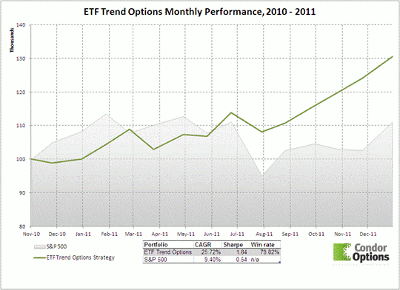Jared Woodard of Condor Options explains how options on ETFs have worked well to combine trend following and options spreads in one strategy.
Historically, two of the most successful approaches to trading have been trend following and option selling. Trend following and momentum investing are strategies known to just about everybody, and option selling (i.e. collecting the volatility risk premium), while not quite as famous, is hardly a closely-held secret.
Usually, these two approaches are treated as strangers.
Momentum/trend traders are conceptually long volatility in that they are willing to accept small, frequent losses from choppy markets in order to reap gains from large price swings in one direction.
A stock or futures position with a trend-based rule set in place will have a similar return profile over time to a portfolio that buys straddles. Traders who are net sellers of options, in contrast, are usually looking for mean reversion to dominate, especially if they are doing so from a market-neutral standpoint. Both our iron condor and calendar spread strategies have fit this profile in the past.
See related: Intro to Trading Calendar Spreads
In 2010, I developed a strategy designed to exhibit the best features of both approaches. The strategy uses price-based mechanical indicators to identify situations in which a short-term trend appears to be developing, but instead of taking a long or short position in the underlying asset, it sells out-of-the-money option spreads whose Delta exposure is in line with the predicted trend.
As with any short vertical options spread, as long as the underlying moves sideways or in the predicted direction, the position is profitable.
One advantage of this approach is that it does not risk the “death by a thousand cuts” that so often plagues momentum-based strategies, where you get stopped out with many small losses while waiting for a major trend to emerge.
One disadvantage is that since the profit potential from a risk-defined vertical spread is finite, trades do not often capture the full range of movement exhibited during a trending market.
In terms of the product universe, the strategy tracks a basket of 35 ETFs with actively traded, liquid options covering all major US equity sectors and indexes along with international stocks, bonds, commodities, and currencies. This allows us to capture major macro themes and be diversified.
The strategy is fairly active, with as many as 15 open trades for any one expiration cycle.
I did some basic backtesting, and based on those solid early results, decided to publish the strategy signals for free to newsletter subscribers.
Starting in November 2010, every strategy signal was published and tracked (including exit signals) in this semi-public fashion. After more than a year of out-of-sample trading—and the market turmoil in 2011 provided a great testing ground—we have a better understanding of how well this approach works.
The equity curve and performance data in the above chart include bid/ask slippage and also factor in commissions of $1 per contract. We were previously referring to this in the subscribers area as the “Trend Following Vertical Spread” strategy, but that a pretty unwieldy name. “ETF Trend Options” sounds better to me.
The strategy took a small loss along with the markets last fall, but it recovered more quickly and ended the year up 24% versus a gain of 2.6% for the S&P 500 over the same period.
From a risk management point of the view, one thing I like about this strategy is that it gets on board promptly when a new trend emerges, so that if a sweet market turns sour, new bearish trades are added quickly enough to help offset losses from bullish-facing existing positions, often enabling recovery within the same expiration cycle.
Finally, the high intermarket correlation last year meant that we would get signals in the same direction for a dozen tickers on the same day, sometimes for assets that you would expect to move independently. I applied a modest trend-ranking rule that filtered the signals so that we weren’t putting basically the same trade on a dozen times at once.
By Jared Woodard of Condor Options






















